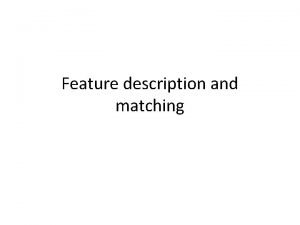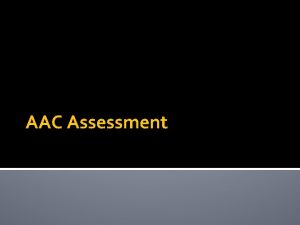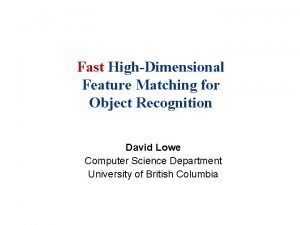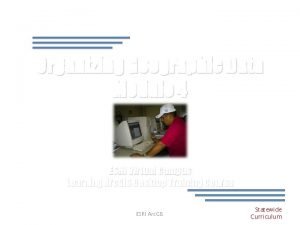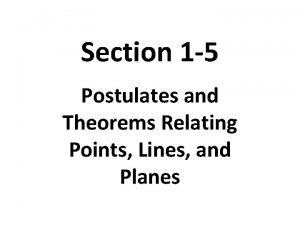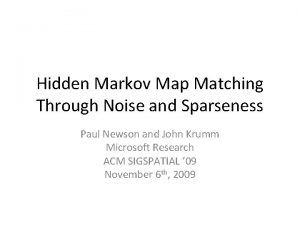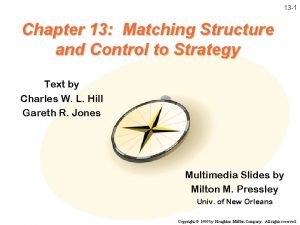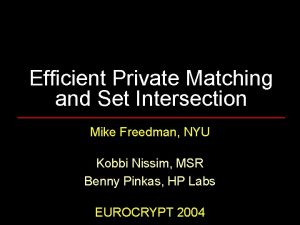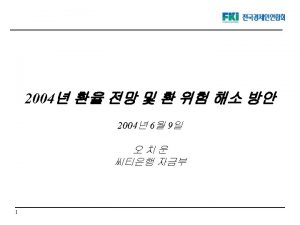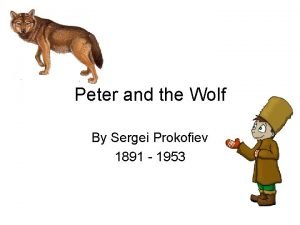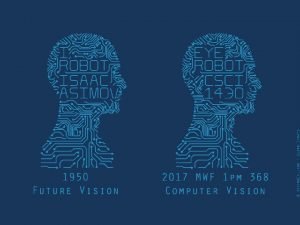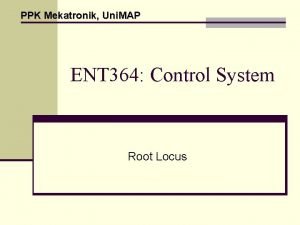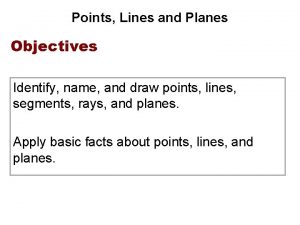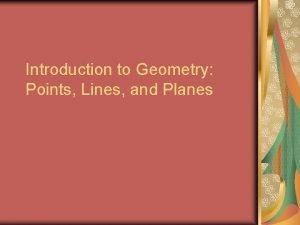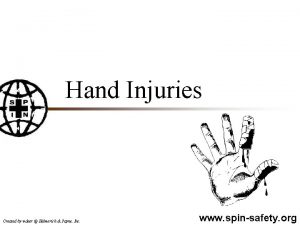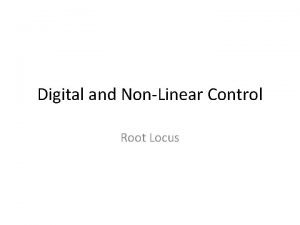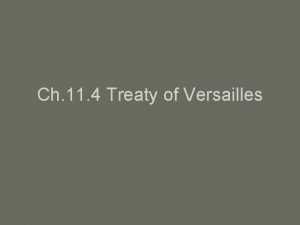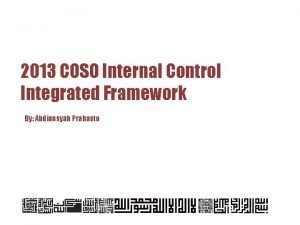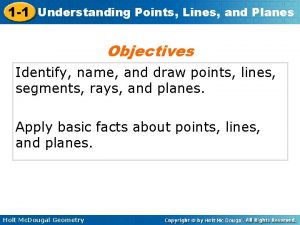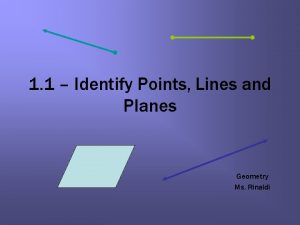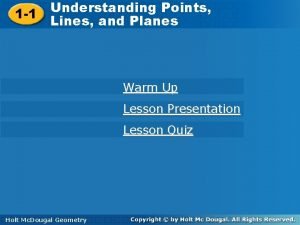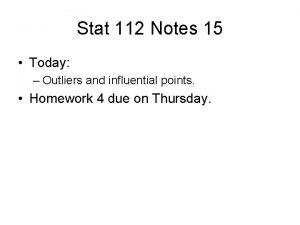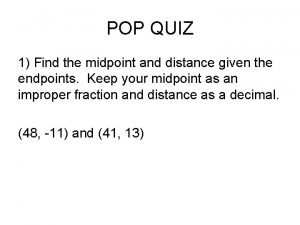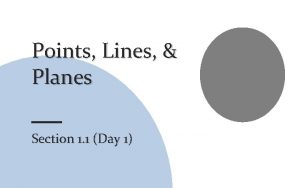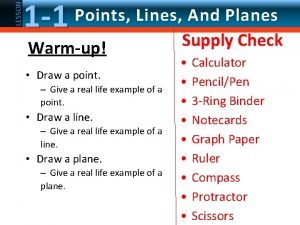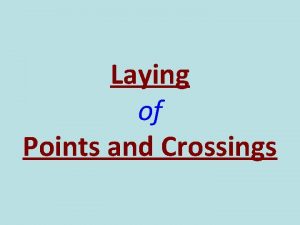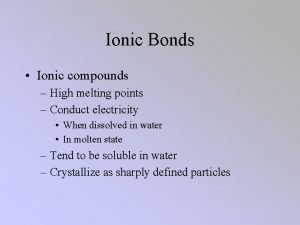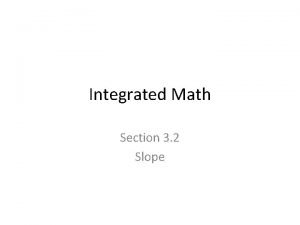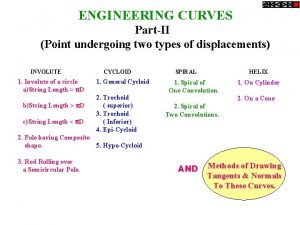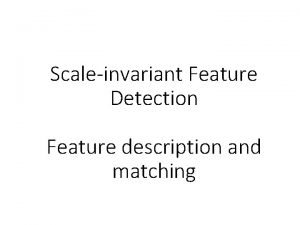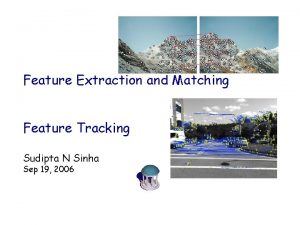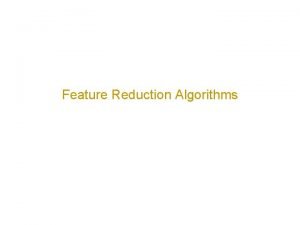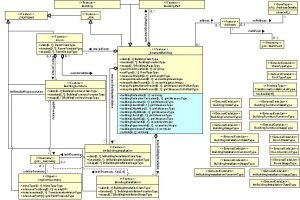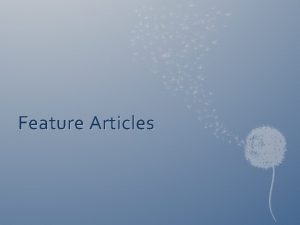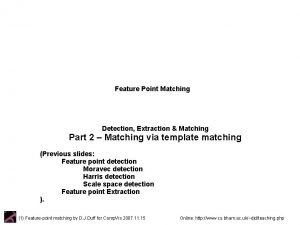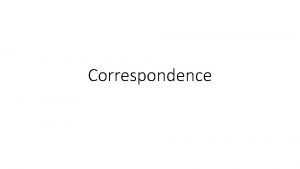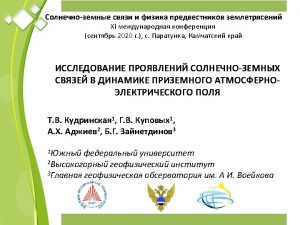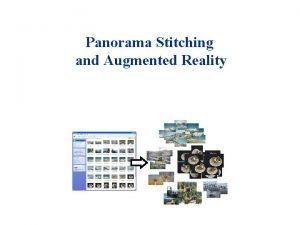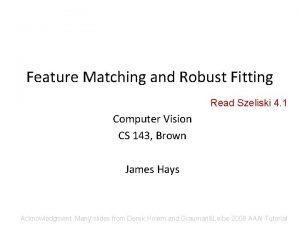Feature description and matching Matching feature points We






































![Rotation Invariance by Orientation Normalization [Lowe, SIFT, 1999] • Compute orientation histogram • Select Rotation Invariance by Orientation Normalization [Lowe, SIFT, 1999] • Compute orientation histogram • Select](https://slidetodoc.com/presentation_image_h/0cb281d8be0179dad79b6fe4e972a1e0/image-39.jpg)













- Slides: 52

Feature description and matching

Matching feature points We know how to detect good points Next question: How to match them? ? Two interrelated questions: 1. How do we describe each feature point? 2. How do we match descriptions?

Feature descriptor

Feature matching • Measure the distance between (or similarity between) every pair of descriptors

Invariance vs. discriminability • Invariance: – Distance between descriptors should be small even if image is transformed • Discriminability: – Descriptor should be highly unique for each point (far away from other points in the image)

Image transformations • Geometric Rotation Scale • Photometric Intensity change

Invariance • Most feature descriptors are designed to be invariant to – Translation, 2 D rotation, scale • They can usually also handle – Limited 3 D rotations (SIFT works up to about 60 degrees) – Limited affine transformations (some are fully affine invariant) – Limited illumination/contrast changes

How to achieve invariance Design an invariant feature descriptor – Simplest descriptor: a single 0 • What’s this invariant to? • Is this discriminative? – Next simplest descriptor: a single pixel • What’s this invariant to? • Is this discriminative?

The aperture problem

The aperture problem • Use a whole patch instead of a pixel?

SSD •

SSD

SSD

NCC - Normalized Cross Correlation •

NCC - Normalized cross correlation

Basic correspondence • Image patch as descriptor, NCC as similarity • Invariant to? – Photometric transformations? – Translation? – Rotation?

Rotation invariance for feature descriptors • Find dominant orientation of the image patch – This is given by xmax, the eigenvector of M corresponding to max (the larger eigenvalue) – Rotate the patch according to this angle Figure by Matthew Brown

Multiscale Oriented Patche. S descriptor Take 40 x 40 square window around detected feature – Scale to 1/5 size (using prefiltering) – Rotate to horizontal – Sample 8 x 8 square window centered at feature – Intensity normalize the window by subtracting the mean, dividing by the standard deviation in the window 40 pi xels 8 pixels CSE 576: Computer Vision Adapted from slide by Matthew Brown

Detections at multiple scales

Rotation invariance for feature descriptors • Find dominant orientation of the image patch – This is given by xmax, the eigenvector of M corresponding to max (the larger eigenvalue) – Rotate the patch according to this angle Figure by Matthew Brown

Detour: Image transformations • • What does it mean to rotate a patch? Each pixel has coordinates (x, y) Rotation represented by a matrix R Pixel’s new coordinates: • I’(x’, y’) = I(x, y)

Detour: Image transformations • What if destination pixel is fractional? • Flip computation: for every destination pixel figure out source pixel – Use interpolation if source location is fractional • I’(x’, y’) = I(x, y)

Multiscale Oriented Patche. S descriptor Take 40 x 40 square window around detected feature – Scale to 1/5 size (using prefiltering) – Rotate to horizontal – Sample 8 x 8 square window centered at feature – Intensity normalize the window by subtracting the mean, dividing by the standard deviation in the window 40 pi xels 8 pixels CSE 576: Computer Vision Adapted from slide by Matthew Brown

MOPS descriptor • You can combine transformations together to get the final transformation x T = ? y

Translate x y T = MT 1

Rotate x y T = MRMT 1

Scale x y T = MSMRMT 1

Translate x y T = MT 2 MSMRMT 1

Crop x y

Detections at multiple scales

Invariance of MOPS • Intensity • Scale • Rotation

Color and Lighting

Out-of-plane rotation

Better representation than color: Edges Normal discontinuity Depth Discontinuity Albedo Edge Shadow

Towards a better feature descriptor • Match pattern of edges – Edge orientation – clue to shape • Be resilient to small deformations – Deformations might move pixels around, but slightly – Deformations might change edge orientations, but slightly

Invariance to deformation by quantization 37 42 Between 30 and 45

Invariance to deformation by quantization

Spatial invariance by histograms 2 blue balls, one red box 2 1 balls boxes
![Rotation Invariance by Orientation Normalization Lowe SIFT 1999 Compute orientation histogram Select Rotation Invariance by Orientation Normalization [Lowe, SIFT, 1999] • Compute orientation histogram • Select](https://slidetodoc.com/presentation_image_h/0cb281d8be0179dad79b6fe4e972a1e0/image-39.jpg)
Rotation Invariance by Orientation Normalization [Lowe, SIFT, 1999] • Compute orientation histogram • Select dominant orientation • Normalize: rotate to fixed orientation 0 T. Tuytelaars, B. Leibe 2

The SIFT descriptor SIFT – Lowe IJCV 2004

Scale Invariant Feature Transform Basic idea: • Do. G for scale-space feature detection • Take 16 x 16 square window around detected feature • Compute gradient orientation for each pixel • Throw out weak edges (threshold gradient magnitude) • Create histogram of surviving edge orientations 0 2 angle histogram Adapted from slide by David Lowe

SIFT descriptor Create histogram • Divide the 16 x 16 window into a 4 x 4 grid of cells (2 x 2 case shown below) • Compute an orientation histogram for each cell • 16 cells * 8 orientations = 128 dimensional descriptor Adapted from slide by David Lowe

SIFT vector formation • Computed on rotated and scaled version of window according to computed orientation & scale – resample the window • Based on gradients weighted by a Gaussian

Ensure smoothness • Trilinear interpolation – a given gradient contributes to 8 bins: 4 in space times 2 in orientation

Reduce effect of illumination • 128 -dim vector normalized to 1 • Threshold gradient magnitudes to avoid excessive influence of high gradients – after normalization, clamp gradients >0. 2 – renormalize

Properties of SIFT Extraordinarily robust matching technique – Can handle changes in viewpoint • Up to about 60 degree out of plane rotation – Can handle significant changes in illumination • Sometimes even day vs. night (below) – Fast and efficient—can run in real time – Lots of code available: http: //people. csail. mit. edu/albert/ladypack/wiki/index. php/Known_impl ementations_of_SIFT

Summary • Keypoint detection: repeatable and distinctive – Corners, blobs, stable regions – Harris, Do. G • Descriptors: robust and selective – spatial histograms of orientation – SIFT and variants are typically good for stitching and recognition – But, need not stick to one

Which features match?

Feature matching Given a feature in I 1, how to find the best match in I 2? 1. Define distance function that compares two descriptors 2. Test all the features in I 2, find the one with min distance

Feature distance How to define the difference between two features f 1, f 2? – Simple approach: L 2 distance, ||f 1 - f 2 || – can give good scores to ambiguous (incorrect) matches f 1 f 2 I 1 I 2

Feature distance How to define the difference between two features f 1, f 2? • Better approach: ratio distance = ||f 1 - f 2 || / || f 1 - f 2’ || • f 2 is best SSD match to f 1 in I 2 • f 2’ is 2 nd best SSD match to f 1 in I 2 • gives large values for ambiguous matches f 1 f 2' I 1 I 2 f 2

 Brand positioning bullseye example
Brand positioning bullseye example Point of difference and point of parity
Point of difference and point of parity Mops descriptor
Mops descriptor Aac evaluation genie
Aac evaluation genie Feature matching
Feature matching Feature dataset vs feature class
Feature dataset vs feature class Isolated feature combined feature effects
Isolated feature combined feature effects Postulates and theorems relating points lines and planes
Postulates and theorems relating points lines and planes Hidden markov map matching through noise and sparseness
Hidden markov map matching through noise and sparseness Matching structure
Matching structure Efficient private matching and set intersection
Efficient private matching and set intersection Spontaneous budget explorers
Spontaneous budget explorers Cengage chapter 4 answers
Cengage chapter 4 answers Key tactics in choosing different brand elements
Key tactics in choosing different brand elements Netting and matching
Netting and matching Matching supply and demand in supply chain
Matching supply and demand in supply chain Patient identification and procedure matching
Patient identification and procedure matching Line of reflection
Line of reflection Peter in the wolf instruments
Peter in the wolf instruments Shape matching and object recognition using shape contexts
Shape matching and object recognition using shape contexts Feature
Feature Shape matching and object recognition using shape contexts
Shape matching and object recognition using shape contexts Treaty of versailles vs wilson's 14 points
Treaty of versailles vs wilson's 14 points Wilt thou be gone it is not yet near day
Wilt thou be gone it is not yet near day Key points of romeo and juliet
Key points of romeo and juliet Romeo and juliet key themes
Romeo and juliet key themes Quadratic graphs roots and turning points
Quadratic graphs roots and turning points Root locus break in point
Root locus break in point Point a lies in plane p illustration
Point a lies in plane p illustration Diamond melting point
Diamond melting point Position bresenhams line algorithm
Position bresenhams line algorithm Points lines and planes geometry
Points lines and planes geometry Helmerich maneuver
Helmerich maneuver 1-1 points lines and planes
1-1 points lines and planes Ppt on computer graphics
Ppt on computer graphics Angle and magnitude condition of root locus
Angle and magnitude condition of root locus Treaty of versailles vs wilson's 14 points
Treaty of versailles vs wilson's 14 points 3 realms of heaven
3 realms of heaven 2019 kcse grading system
2019 kcse grading system Coso 2013 cube
Coso 2013 cube 1-1 understanding points lines and planes
1-1 understanding points lines and planes Examples of points lines and planes
Examples of points lines and planes Lesson 1-1 understanding points lines and planes
Lesson 1-1 understanding points lines and planes Melting point trend group 1
Melting point trend group 1 Outliers and influential points
Outliers and influential points Quiz distance and midpoint
Quiz distance and midpoint Naming a plane
Naming a plane 1-1 points lines and planes
1-1 points lines and planes Lesson 1-1 points lines and planes
Lesson 1-1 points lines and planes Similar flexure turnout
Similar flexure turnout Ionic bond melting point
Ionic bond melting point Assignment 12 slope from two points and tables
Assignment 12 slope from two points and tables What is engineering curves
What is engineering curves


